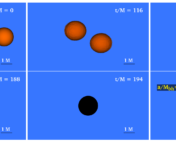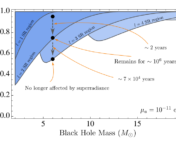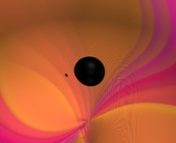Authors: Marcelle Soares-Santos, Antonella Palmese, et al. (DES, LIGO, and Virgo collaborations)
First Author’s Institution: Brandeis University (M. S.-S.), Fermi National Accelerator Laboratory (A. P.)
Status: Submitted to the Astrophysical Journal Letters, open access on ArXiv
Disclaimer: The author is a member of the Dark Energy Survey but works on a different topic and did not take part in this analysis.
Nearly all of the galaxies we observe in the night sky are rushing away from us. Only the Andromeda galaxy is moving toward us — we are trapped in a gravitational dance that will end in a major collision about 4.6 billion years from now. The remainder of galaxies are receding due to the expansion of the universe. But how fast are the rest of the galaxies flying away from us? This is actually a difficult question to answer, partly because it is difficult to accurately measure distances across the universe. Today’s paper details a new method to measure how quickly the universe is expanding using the gravitational wave (GW) signals from binary black hole collisions.
The Sounds of the Universe
Gravitational waves are ripples of spacetime itself, analogous to sound waves traveling through the air. They are generated in violent collisions between compact objects like neutron stars and black holes. The LIGO and Virgo collaborations have detected 11 such collisions, ten of which have been the collisions of two black holes (see Figure 1). The frequency and amplitude of the GWs, or the pitch and volume of the “sound,” encode information about the mass of the merging system and how far away it is. Exactly how the signal evolves tells us everything we need to know about the gravitational “brightness,” or luminosity, of the event. By comparing the measured amplitude to the calculated amplitude, we get a precise distance to the source. The ability to do this with GW signals has earned their sources the name “standard sirens.”
What does this have to do with measuring the expansion rate of the universe? Hubble’s Law tells us that the velocity v at which an object at redshift z recedes away from us depends on its distance from us: v(z) = H0d, where H0 is the expansion rate of the universe. Previous measurements of this parameter, called the Hubble constant, have used electromagnetic (EM) radiation from either the Cosmic Microwave Background (CMB) or Type Ia supernovae. These measurements currently conflict with one another, suggesting there might be some missing physics in our understanding of the universe. Further, measuring distances in the universe is tricky. CMB and Type Ia supernovae measurements rely on the cosmic distance ladder, so errors from one rung will propagate to the next.
On the other hand, standard sirens with EM counterparts don’t rely on the cosmic distance ladder and so offer an independent way to measure H0. In this case, the EM signal pins down the host galaxy, which gives the redshift of the signal and thus its velocity, and the GW signal gives the precise distance to the signal. In fact, this has already been done using the binary neutron star merger GW170817. But we need many more than one binary neutron star event to truly pin down H0 (Figure 3), and ten of the 11 LIGO/Virgo events have not had accompanying EM signals. Today’s paper shows that there is still a way to calculate H0 from these events!
Listening in the Dark
The authors of today’s paper report the first measurement of H0 using the “dark” siren GW170814, a GW signal from two colliding black holes with no accompanying electromagnetic radiation. Recall from Hubble’s Law that we need a distance and a redshift to calculate H0 — but to determine a redshift, we need to know what galaxy the source was located in. That’s a hard thing to determine with no electromagnetic counterpart signal. The probability maps produced by LIGO/Virgo for the on-sky location of the GW signal can encompass a large area containing tens of thousands of galaxies at as many different redshifts!
GW170814 happened to fall smack in the middle of the Dark Energy Survey (DES, see Figure 2). DES has produced exquisite galaxy maps of a quarter of the Southern Hemisphere sky, complete with estimated redshifts calculated from the coarse “spectrum” of DES’s five wavelength filters. Soares-Santos, Palmese, et al, devised a statistical analysis that selected potential host galaxies from DES’s galaxy maps using the LIGO/Virgo maps and calculated what H0 would be for each in turn.
After analyzing 77,000 galaxies, the authors calculate H0 to be 75.2 +(-) 39.5(32.4) km s-1 Mpc-1. Figure 3 shows how this value compares to previous measurements using the CMB and Type-Ia supernovae. While the uncertainties are quite large using only one GW event, the authors estimate that uncertainties comparable to the CMB and supernovae measurements are possible with ~100 GW events. Improvements to the LIGO detectors were recently completed and the observatory’s third run (O3) starts today, April 1st! (No this is not an April Fool’s joke.) There could potentially be a dark siren event every week, meaning we might only have to wait a couple of years to measure H0 to sufficient precision using GW events!
Having a new way to measure H0 is a big deal for potentially resolving the tension between the CMB and supernovae measurements. If the dark/standard siren methods, which probe the late-time universe, end up being consistent with the early-universe CMB results, that might imply that something is wrong with our cosmic distance ladder and the late-universe supernovae measurements. On the other hand, if the GW measurements are consistent with the supernovae results, we might need to add new physics to our current understanding of the universe to explain why H0 would evolve with time. Either way, the next few years will be a very exciting time in precision cosmology!




